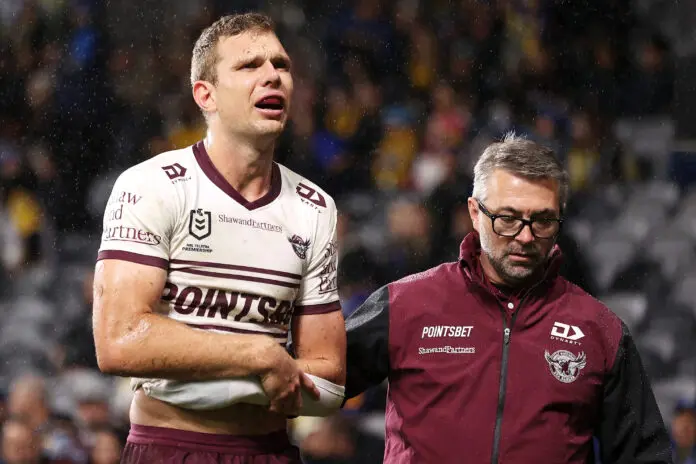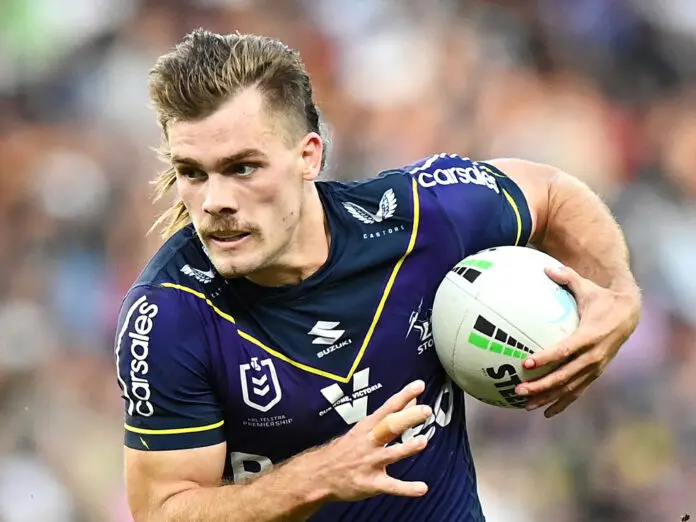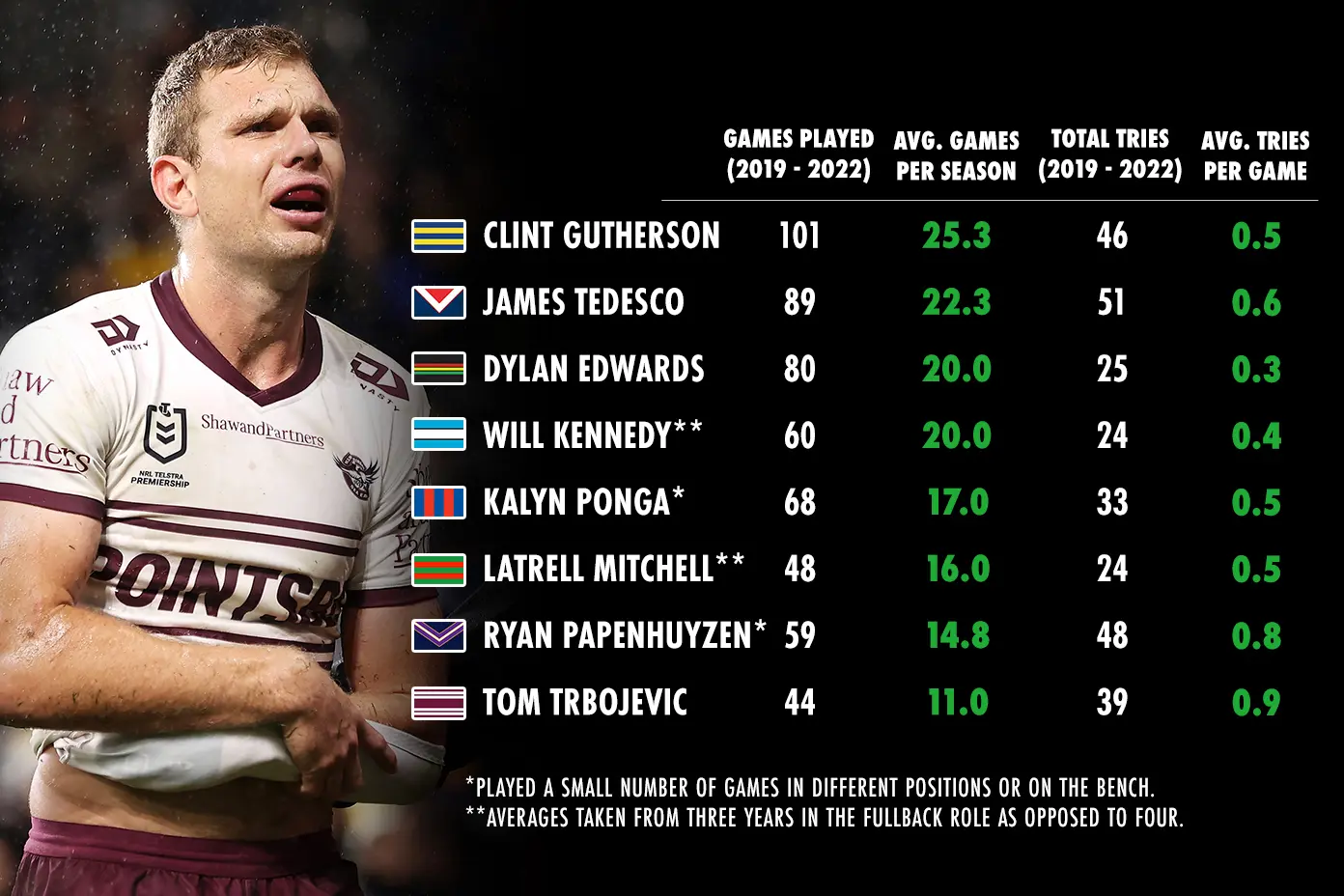Few could argue that the fullback is a team's most important player on the rugby league field.
The role requires a unique set of skills that even Liam Neeson would struggle to master. Pace, strength, creativity, a high football IQ and a solid defensive ability are just some of the criteria required, and often at the same time.

From the first point of attack on a kick-return to the last line of defence required to make show-stopping try-savers, it requires a special kind of talent to truly succeed in the role.
Our modern game is full of talented fullbacks. If anything, we're spoilt for choice.
Few could argue James Tedesco is the prime No.1 with any real conviction. He's a model of consistency who is ever-reliable and a frequent performer on the biggest stage.
But lucky for us, there are a number of other iconic fullbacks in the modern game, and while Teddy may earn most of the plaudits, few come with more hype or expectation than Manly's excitement machine, Tom Trbojevic.
Sadly, his terrible run with luck refuses to abate. Reports have streamed in this week confirming the star custodian has once again suffered a pre-season injury, with scans confirming that Trbojevic will now be sidelined for 6-8 weeks.
Described simply as a ‘hamstring' issue, it's hard to know just how long he'll be out for before scans come back (he may be back by Round 1) – but it doesn't bode well for a player that has regularly struggled with injury issues.
Is this an issue for all of the game's best fullbacks thanks to the demands of the role? Or is it something more attributable to the man himself?
While they can't account for the infinite variables, a look at the numbers tells us a bit more.
While it's clear that something is not right in terms of Trbojevic's injury troubles, it's less clear what the problem actually is.
Trbojevic has had a more luckless and injury-affected time at fullback than any of his compatriots who've played the role regularly over a similar length of time.
His four-year average of just 11 games per season may seem cherry-picked, but it only improves slightly when stretched out over his whole career (15 games per season).
He's got the talent and ability to win a game single-handedly and justify his price tag along the way – but how far does that talent go if he's only available for about half a season? – And no, you don't get to choose which half.
It's worth noting that both Cronulla's Will Kennedy and South Sydney's Latrell Mitchell have played more games at the back than Trbojevic, despite being in the role for a year less at their respective clubs.
It should also come as no surprise that, outside of Tedesco, the game's two most consistent fullbacks – in terms of availability – have been Clint Gutherson and Dylan Edwards.
This year's grand final fullbacks have both enjoyed limited injuries and averaged 20+ games per season over that same period, with Gutherson playing more than twice as many games as Trbojevic.
Scoring vs security
It's not all grim for Tom though. Aside from the damning number of missed games, there's another eye-catching element to his stats that sets him apart.
Trbojevic's ratio of 39 tries in 44 appearances not only highlights his importance to the Sea Eagles' attack, it demonstrates the different role he plays to most of his counterparts.
He scores 0.9 tries per game or, conversely, a try every 1.1 appearances. Meanwhile, Clive Churchill Medal winner and back-to-back premier Dylan Edwards scores a try every 3.2 games. That's a yawning gap in output – although Edwards, and Penrith, are obviously fine with that.

It's clear that Trbojevic's role at the Sea Eagles is different, and perhaps that could go some way to explaining the frequency of injuries, at least in comparison.
It's also notable that the only other fullback with a strike rate similar to Trbojevic – Melbourne's Ryan Papenhuyzen – is closest to him in both key criteria.
While both ‘Turbo' and ‘Paps' are streets ahead of the rest for scoring rate, they're also languishing far behind everyone else in terms of appearances and average availability.
Melbourne has benefitted from depth in the role in the past, but they certainly took a step backward when Papenhuyzen spent most of 2022 injured and they could no longer call upon Nicho Hynes.
The numbers imply that the more important a role the fullback plays at the attacking end, the more susceptible they're going to be to regular injuries - but that decrease in availability is counter-balanced with a much higher contribution to scoring output.
Papenhuyzen has played 42 fewer games than ‘King Gutho', but has already scored more tries. Both have taken their teams to a grand final in the sample period – but only one of them won – and it wasn't the guy who was available more.
Risk vs reward
Ultimately these numbers seem to point to the age-old question of risk vs reward.
Is it worth having a Papenhuyzen or Trbojevic in your roster - someone who is capable of a Dally M or Clive Churchill Medal-winning effort - if they're only going to be available for between 10-15 games per season?

Is it worth banking on that player having at least one or two years where they can avoid injury long enough to bring your club to the cusp of greatness during their career? Is it worth the risk?
Or is it better to have a consistent and reliable player at the back who doesn't break the line or score as often but offers a steady influence behind leading halves and, more importantly, can stay fit?
The success the Panthers and Eels have had in recent years would indicate the latter – but will this see the game slowly move away from the excitement machines of days gone by? If we're not lauding someone as the next Brett Mullins, is there any point?
A good fullback is absolutely essential to a team's premiership hopes, and I'm well aware that boiling it down to a simple matter of availability and scoring output ignores all the subtle and barely-noticeable things a good fullback does.
But you can't tell me those numbers don't paint a clear picture.
The Tedesco era
It still seems that the best fullback is one who can strike the perfect balance – a durable and resilient custodian who can still break a game open and lead the line.
And in that respect, it's easy to see why James Tedesco is considered the game's best.
Yes, he averages three games per season fewer than Gutherson – but ‘King Gutho' doesn't play Origin, so that small gap is negligible. Tedesco is also third on the list behind Turbo and Papenhuyzen for tries per game.
It's a perfect balance, a fullback who doesn't just score regularly and offer another dangerous outlet, but can be relied upon to be fit and available – and lead the team – more often than not.
In a club where every member of the back-line can play fullback and Joey Manu and Joseph Suaalii HAVE done for their nations, there's a reason Tedesco's still got the jersey.
In a NSW Origin side with Tom Trbojevic available, it's still Teddy that plays in the No.1. When Australia comes calling, there's only one man they want at the back – and it's not hard to see why.
The question of legacy is a lot harder to assess when it comes to active players, but there's no doubt that Tedesco will emerge as one of this era's greatest.

For all of Tom Trbojevic's problems, the sheer impact he makes on the field when available and a Dally M win means that he'll likely stand higher in the general rugby league memory than Edwards or even Gutherson.
You'd be hard-pressed to find anyone in the rugby league community who wishes this kind of luck on Trbojevic. We all want to see him fit and available and at his damaging best because, deep down, we're all curious about just how far his talent can take that Manly team.
But if given a choice between a game-breaking talent who brings headlines and attention for a limited time, vs an industrious and consistent achiever who can win back-to-back premierships, I'd go with the latter.
That's if James Tedesco isn't available...







